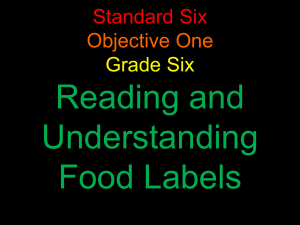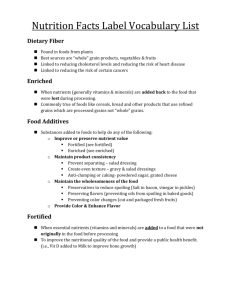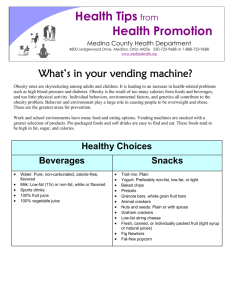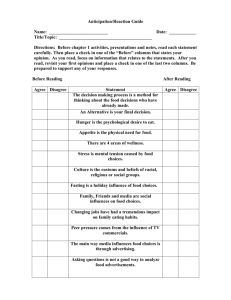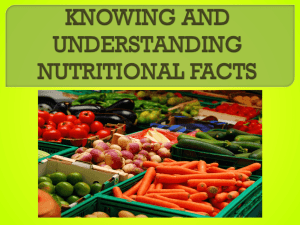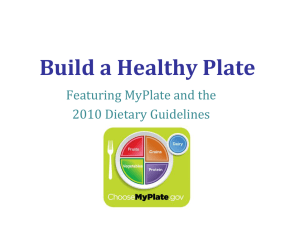Reading food labels
advertisement
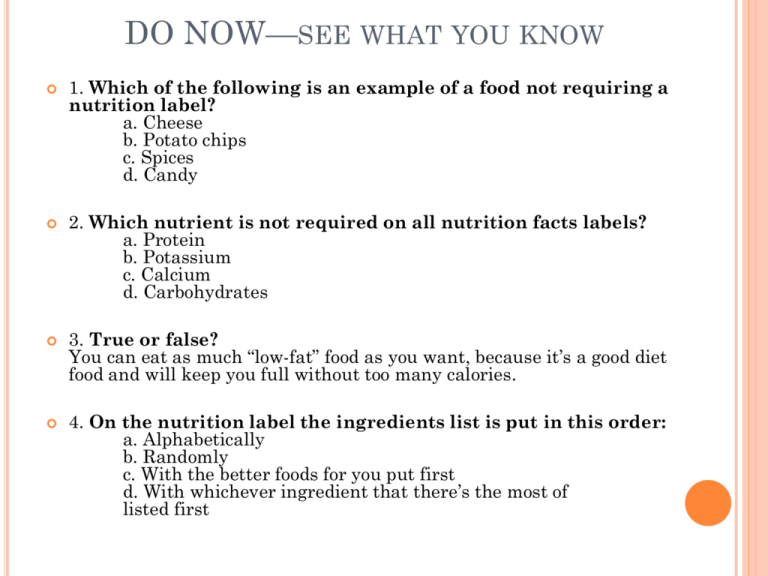
DO NOW—SEE WHAT YOU KNOW 1. Which of the following is an example of a food not requiring a nutrition label? a. Cheese b. Potato chips c. Spices d. Candy 2. Which nutrient is not required on all nutrition facts labels? a. Protein b. Potassium c. Calcium d. Carbohydrates 3. True or false? You can eat as much “low-fat” food as you want, because it’s a good diet food and will keep you full without too many calories. 4. On the nutrition label the ingredients list is put in this order: a. Alphabetically b. Randomly c. With the better foods for you put first d. With whichever ingredient that there’s the most of listed first ANSWERS 1. c. Spices 2. b. Potassium 3. False 4. d. With whichever ingredient that there’s the most of listed first READING FOOD LABELS We will analyze strategies using tools (My Pyramid, My Plate, and Food Facts Label) to plan healthy nutrition Food Label Video WHICH FOOD WOULD YOU PREFER TO HAVE IF YOU WERE STRANDED ON A DESERTED ISLAND? WHY? A. Ingredients Sugar, partially hydrogenated vegetable oil (may contain one of more of the following oils: coconut, cottonseed, palm kernel, canola or soybean), corn syrup, sodium caseinate (a milk derivative), natural and artificial flavors, dipotassium phosphate, mono and diglycerides, salt. B. Ingredients Fish, sufficient water for processing, shrimp, guar gum, steamed bone meal, titanium dioxide, potassium chloride, salt, iron oxide (vitamins E, A, D3, B-12), thiamin monooxitrate (vitamin B1), ferrous sulfate, zinc sulfate, magnesium sulfate, copper sulfate, pyridoxine hydrochloride (vitamin B-6), natural flavor, niacin, calcium, pantothenate, riboflavin, supplement (vitamin B-2), cobalt carbonate, menadione sodium bisulfate complex (source of vitamin K activity), folic acid, potassium iodide and biotin. C. Ingredients Sugar, corn syrup, food starch-modified, apple juice from concentrate, less than 1.5% citric acid, confectioner's glaze, artificial and natural flavors, gum acacia, coloring (includes yellow 5, red 40, yellow 6, blue 1). WHAT ARE THESE FOODS?? A. B. C. Coffee-Mate Creamer Fancy Feast Cat Food Starburst Jelly Beans READING FOOD LABELS Ignore the front of the package hype! Every packaged food must include a list of ingredients. Manufacturers can't actually lie on labeling, but they can stretch the truth when trying to get your attention to buy their product. The ingredient in largest quantity is listed first, while the one in smallest quantity is listed last. Food labels can't tell you what foods to eat — that's SERVING SIZE Start with the serving size amount. All the information on the rest of the label is based on that amount. Sometimes a serving size will be way less than you're used to eating — like only half a cup of cereal. The label will also list how many servings are in the package. Even things that seem like they'd be a single serving, such as a bottle of juice or packet of chips, may contain more than one serving. SERVING SIZES CALORIES A calorie is a way to measure how much energy a food provides to your body. The number on the food label shows how many calories are in one serving of that food. Calories from fat - Food labels show Calories from Fat so you can limit the amount of fat you eat for a healthier diet. No more than 30% of your daily calories should come from fat. Higher fat foods should be eaten in smaller portions. PERCENT DAILY VALUE These percentages show the amounts of nutrients an average person will get from eating one serving of that food based on a 2,000 calorie diet. If a food has a daily value of: 5% or less = low in that nutrient 10-19% = good source of that nutrient 20% or more = excellent source of that nutrient FAT Total fat shows how much fat is in a single serving of food. Too much Obesity Our bodies do need some fat every day. Choose foods that have 3 grams of fat or less for every 100 calories in a serving. Some fats are better than others. Unsaturated fats, which are found in vegetable oils, nuts, and fish, are often called "good fats.” Saturated and trans fats are considered "bad" because they can increase a person's risk for developing heart disease. CHOLESTEROL Cholesterol isn't entirely bad for you — it's important to production of vitamin D and some hormones. Blood cholesterol comes in two major types: HDL (the good kind) and LDL (the bad kind). Too much LDL cholesterol in a person's blood increases the risk of heart disease. So it's a good idea for even teens to watch how much cholesterol they eat, along with saturated and trans fats, which tend to raise levels of LDL cholesterol in the blood SODIUM Sodium is a component of salt. Almost all foods contain sodium. it adds flavor and helps preserve food Processed, packaged, and canned foods usually have more sodium than freshly made foods. Small amounts of sodium keep proper body fluid balance. Too much sodium can increase water retention and blood pressure in people who are sensitive to it. TOTAL CARBOHYDRATE This amount covers all carbohydrates, including fiber and sugar. The best sources of carbohydrates are fruits and vegetables, along with whole-grain foods. Most of your daily calorie intake should come from carbohydrates. Sugars are found in most foods. When a food contains lots of sugar, the calories can add up quickly. Soda, candy, and other foods that are high in added sugar are considered "empty calories" because they usually don't offer a lot of other nutrients. FIBER Fiber helps keep your digestive system healthy. Fiber can also help reduce cholesterol levels. Best of all, fiber has no calories and it can help you feel full. Check the label and pick foods that have at least 3 grams of fiber per serving. Can you name some foods that are high in fiber? PROTEIN Most of the body — including muscles, skin, and the immune system — is made up of protein. If the body doesn't get enough fat and carbohydrates, it can use protein for energy. Be sure the foods you eat give you some protein. Name some foods that are high in protein. VITAMINS & MINERALS Choose foods that are high in a variety of vitamins and minerals. The FDA requires food manufacturers to include information about vitamin A, vitamin C, calcium and iron. Sometimes you'll see other important vitamins and minerals listed on the label, especially if the product contains significant amounts. Some vitamins — like vitamin C — are water soluble, which means that the body can't store them so they need to be consumed daily. NUTRITIONAL CLAIMS: Fat-Free - Less than 1/2 gram of fat per serving Low-Fat - 3 grams of fat or less per serving Reduced Fat - 25% less fat than the original product Light - 50% less fat than the original product Low Cholesterol - 20 milligrams or less of cholesterol and 2 grams or less of saturated fat per serving Sodium Free - Less than 5mg of sodium Sugar Free - Less than 1/2 gram of sugar High Fiber - 5 grams or more of fiber ARE YOU SMARTER THAN A FOOD LABEL? FOOD LABELS MAY NOT BE TELLING THE TRUTH PRACTICE We will now practice reading and analyzing food labels You may work in groups of 3-4 Your group will hand in 1 paper Make sure you all put your names on it!!

